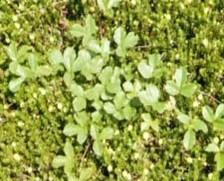Dewberries and Brambles (2001)
Two different species of Rubus commonly occur on commercial cranberry bogs: bristly dewberry (Rubus hispidus) and prickly dewberry (Rubus flagellaris). Upright bramble (Rubus allegheniensis) was more prevalent in the 1970’s-1980’s, but is typically controlled in the field by a rust pathogen (see photo next page). Currently, it is rarely seen on bogs in Massachusetts. Thus, further mention of dewberries or brambles in this fact sheet refers only to R. hispidus and R. flagellaris. The range of these weed pests extends through a wide range of habitats, from Quebec and Nova Scotia west to Wisconsin and Minnesota and south to North Carolina and Georgia. Rubus species are characterized by growth in disturbed habitats, often representing an early stage of plant succession (in nonagricultural settings). On cranberry plantings, infestations tend to occur in small to large patches on the high edges. They are present on ditch banks and may spread onto the bog by rhizomes (underground stems). It is also believed that new infestations could occur from seeds disseminated through bird droppings.
Taxonomy
The taxonomy of Rubus is difficult to sort out as many species hybridize and exhibit polyploidy (more than twice the usual number of chromosomes). The genus is in the family, Rosaceae (the rose family), and 25 species are described in an authoritative flora (Gleason and Cronquist, 1991). The genus as a whole is known by the common name, brambles, but the species that occur in MA are identified by their common names, swamp dewberry (R. hispidus) and Northern dewberry (R. flagellaris). In Massachusetts, growers sometimes interchange the group names, brambles and briers, but these are two distinct genera of plants. In fact, they fall into two separate major categories of plant types. Briers are monocotyledons (one true leaf emerges from the seed) classified to the genus, Smilax. Rubus species are dicotyledons (two true leaves emerge from the seed). Common to MA bogs are glaucous greenbrier or silverleaf (Smilax glauca) and greenbrier (S. rotundifolia). It is important to distinguish between these weed species as many of the available management options control Rubus species, but not Smilax species (see figure on back page).
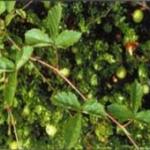
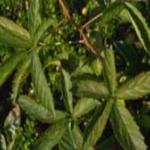
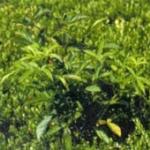
Bramble and Dewberry Biology
Brambles and dewberries are perennial plants that produce biennial canes. The canes are normally vegetative the first year . At this point in their life cycle, these are called primocanes. These same canes flower during the second year and are referred to as floricanes. After fruiting, the floricanes die and new primocanes are produced (Pritts and Handley, 1989). The crown of the plant (the portion between the root and the stem) and the roots may live for many years. Brambles and dewberries have upright and arching to trailing stems (3-4 m) arising from root buds (Uva et al., 1997). Brambles spread by seed, root sprouts, rhizomes, and stems that arch to the ground and generate roots at the tips. Dewberries spread rapidly on cranberry bogs by rooting at the tips of their canes. Dewberries will form a dense thicket and kill vines if left unmanaged. Stems (or runners) have been known to grow to lengths over 15 feet. All brambles and dewberries have roots that are woody and tough. Vegetative growth continues until cold weather predominates.
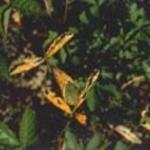

Flower bud initiation occurs in the late fall, followed by flower development the next summer on the floricanes (Pritts and Handley, 1989). Like many plants, overall dewberry productivity and health is dictated by the interaction of many environmental factors including light, temperature, day length, soil moisture, and wind. Brambles and dewberries grow best in drier soils. This is why infestations by dewberries in cranberry bogs are typically seen on the high edges and not in the moist centers of the bog. Though wind may injure commercial species of Rubus (e.g., raspberry), wind does not normally adversely affect brambles that grow in cranberry bogs.
Flowers and Fruit
The flowers contain 5 petals and 5 small, non-showy sepals. The flowers are small and white. Dewberries flower from June through September and produce red or black fruit from July through October. Dewberries and brambles are self-fertile, which means that pollen transferred from within the same flower can produce a viable fruit. Honeybees, which are used to pollinate cranberry flowers, are also excellent pollinators for the dewberries and brambles. Flowers typically contained 100-125 pistils (the female portion of the flower). Each pistil contains two ovules; one develops into the mature seed and the other becomes the drupelet (the fleshy tissue) that surrounds the seed. Usually 75-85 drupelets aggregate together to form the berry.
Management
The most effective way to mange dewberries is to eliminate them as they invade the bog. Remove young plants by pulling or digging out roots. Chemical control with glyphosate wipes is difficult because the weeds grow so intimately amongst the vines. However, wiping does stall the spread of dewberry patches and offers some management of the weed. Some growers have
had moderate to good success using hand-held clippers that dispense an herbicide as they cut. Growers have reported good results by tying up the runners onto stakes and then hand wiping with glyphosate. This technique prevents excessive vine injury by allowing the herbicide to dry on the weeds in a vertical position prior to placing them back on the bog surface. Late water floods (4 weeks duration) increased crown mortality and reduced the numbers of runners (offspring) produced by a crown (DeMoranville et al., 1998). The figure below shows that a late water flood adversely affected the trailing dewberry species (3 different bogs), but had no impact on silverleaf (Smilax glauca). Specifically, research indicated a 20% increase in crown mortality and a 30% reduction in the number of runners produced per crown for dewberries held under a proper late water flood (see table this page). Long summer floods can be used in desperate situations. This flood eliminates the crop for the year. Some growers have found it helpful to hand-pull or hand-wipe remaining dewberry plants after the removal of the summer flood. Fall floods have also shown promise for management of dewberry populations (DeMoranville et al., 2001; Shumaker and DeMoranville, 2000). These studies have focused primarily on R. hispidus. All floods for the study were established by holding the harvest flood for either 3 or 4 weeks. Dewberry crowns increased 2-7% after a 3- week flood, but decreased 27-31% after 4-week floods. Data from these studies, along with previous grower observations, suggest that a 4-week flood may be necessary for control of dewberry populations. In addition, putting the flood on early in the harvest period (September 20-25) was key to good dewberry control. However, some control of dewberry was obtained with a 4-week flood starting during the first week of October. Current recommendations are to start flooding as early as possible and hold for 4 weeks for best dewberry management. It is probable that good results are correlated with water temperature and oxygen levels. Research planned for 2001 is directed towards answering these questions. Early floods are best suited to early varieties or on beds where a crop-destruct flood has been used. It is important to remove the flood by early November to allow the vines time to become dormant prior to the onset of winter. Vines may be susceptible to injury if cold temperatures occur soon after the withdrawal of the fall flood.
Literature Cited
DeMoranville, C.J., A.L. Averill, F.L. Caruso, H.A. Sandler, and M.J. Else. 1998. Control of weeds, insects, and diseases on cranberry with a spring flood. HortScience (abstr.) 33:538. DeMoranville, C.J., H.A. Sandler, A.L. Averill, M.M. Sylvia, and D. Shumaker. 2001. Integrated management of cranberry pests using fall and spring floods. HortScience (abstr.), in press. Else, M.J. 1994. Identifying briars and brambles. Cranberry weed IPM fact sheet. UMass Extension Publ. University of MA-Amherst. Gleason, H.A. and A. Cronquist. 1991. Manual of the vascular plants of the Northeastern United States and adjacent Canada. Second Edition. New York Botanical Garden, Bronx, NY. 910 pp. Pritts, M. and D. Handley. 1989. Bramble production guide. Northeast Regional Agricultural Engineering Service-35. Ithaca, NY. Shumaker, D. and C.J. DeMoranville. 2000. A good year to try a fall flood. Cranberry Station Newsletter, September. UMass Ext. Publ., East. Wareham, MA. Uva, R.H., J.C. Neal, and J.M. Tomaso. 1997. Weeds of the Northeast. Cornell University Press, Ithaca, NY. 397 pp.
Bristly Dewberry
- roots at tips of runners, spreads rapidly
- runners 4-8 feet in length
- leaves small (1-2”), dark, glossy green
- ‘thorns’ are fine and hair-like, closely spaced
- leaves are in groups of three
- grows at vine level, so control with wiping can be difficult
- can kill vines when very dense
Prickly Dewberry
- roots at tips of runners, spreads rapidly
- runners 6-12 feet in length
- leaves large (~3”), light-medium green
- thorns sharp and hard, spaced at intervals along stem
- leaves are in groups of three
- grows at vine level, so control with wiping can be difficult
- can kill vines when very dense
Upright Bramble
- grows upright, not trailing on ground
- spreads by underground runners, not rooting at tips
- leaves small, light to medium green
- leaves are in groups of three to five
- may see orange rust on leaves during summer
- easier to control (upright habit) and spreads more slowly than the dewberry species
Glaucous sawbrier
- grows in dense stands, patches spread rapidly
- short in stature, usually grows amongst vines
- leaves dull gray, may have white markings
- underside of leaf is silvery or white
- very hard to control, may significantly decrease yields
Greenleaf sawbrier
- bushy, grows in slowly spreading clumps
- tall in stature, usually grows well above vines
- leaves bright shiny green
- underside of leaf is also green
- not as damaging to yield as glaucous greenbrier
